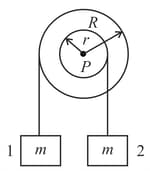B M Sharma Solutions for Chapter: Rigid Body Dynamics: Part 1, Exercise 6: CONCEPT APPLICATION EXERCISE
B M Sharma Physics Solutions for Exercise - B M Sharma Solutions for Chapter: Rigid Body Dynamics: Part 1, Exercise 6: CONCEPT APPLICATION EXERCISE
Attempt the practice questions on Chapter 3: Rigid Body Dynamics: Part 1, Exercise 6: CONCEPT APPLICATION EXERCISE with hints and solutions to strengthen your understanding. Physics For Joint Entrance Examination JEE (Advanced): Mechanics II solutions are prepared by Experienced Embibe Experts.
Questions from B M Sharma Solutions for Chapter: Rigid Body Dynamics: Part 1, Exercise 6: CONCEPT APPLICATION EXERCISE with Hints & Solutions
A uniform rod of mass m and length can rotate in a vertical plane about a smooth horizontal axis hinged at point .

(a) Find angular acceleration of the rod just after it is released from initial horizontal position from rest?
(b) Calculate the acceleration (tangential and radial) of point at this moment.
A uniform rod of mass and length can rotate in a vertical plane about a smooth horizontal axis hinged at point . Find the force exerted by the hinge just after the rod is released from rest, from an initial horizontal position?

A wheel of radius and moment of inertia about its axis is fixed at the top of an inclined plane of inclination as shown in figure. A string is wrapped around the wheel and its free end supports a block of mass which can slide on the plane. Initially, the wheel is rotating at a speed in a direction such that the block slides up the plane. How far will the block move before stopping?
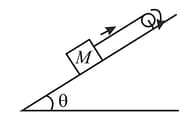
A uniform rod of mass and length is placed on a sharp support such that and . A spring of force constant is attached to end as shown in figure. To keep the rod horizontal, its end is tied with a thread such that the spring is elongated by . Calculate reaction of support when the thread is burnt.
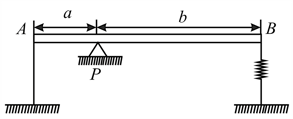
A uniform solid cylinder , of mass , can freely rotate about a horizontal axis fixed to a mount , of mass . A constant horizontal force , is applied to the end , of a light thread tightly wound on the cylinder. The friction between the mount and the supporting horizontal plane is assumed to be absent. Find:
the acceleration of the point
the kinetic energy of this system, after the beginning of motion.
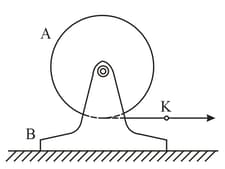
A disc of mass and radius is pivoted smoothly with a block of mass A force acts on and another force acts on . Assume that ground is smooth. Find the:
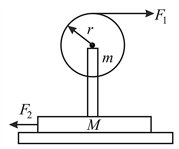
(i) Linear acceleration of the disc.
(ii) angular acceleration of the disc.
A light rigid rod is connected rigidly with two identical particles each of mass m as shown. The free end of the rod is smoothly pivoted at . The rod is released from rest from its horizontal position at . Find:

(i) angular acceleration of the rod, at .
(ii) reaction offered by the pivot, at
Two blocks each of mass m are hanging from a stepped pulley by an inextensible light string which passes over a stepped pulley. The mass of the pulley is and its radius of gyration is . If the string does not slide on the pulley, find the accelerations of the blocks.
